
Transform Your Betacam Tapes to Digital: Expert Services for Every Format
Understanding Betacam Formats
What is Betacam?
Betacam is a family of video formats developed by Sony in the 1980s, which became a dominant standard in the field of professional video broadcasting. The original Betacam format was designed for high-quality video recording for television production, creating a stark contrast with consumer formats of the time. Over the years, various iterations of the Betacam technology have been developed, making it a critical tool for video professionals.
Notably, Betacam tapes are characterized by their ability to record in high resolution and their durable format, using magnetic tape technology. This made Betacam the go-to choice for television stations and media companies, leading to vast archives of content stored on this analog medium that now need conversion to modern digital formats. To learn more about this service, refer to our Betacam to Digital solution.
Different Betacam Versions Explained
The Betacam family consists of several variations that cater to different production needs:
- Betacam
- Betacam SP: Introduced in 1986, Betacam SP was an enhancement that allowed for higher-quality recordings and was used extensively by news stations and production companies until the late 1990s.
- Digital Betacam (DigiBeta): Launched in the mid-1990s, this version provided digital signals with unrivaled clarity for the time, establishing itself as the industry standard.
- Betacam SX: Combining elements of the previous formats, Betacam SX offered both digital capabilities and the robust construction of tape-based media.
With the progression through these formats, it is evident that the Betacam technology has evolved significantly, but many of these tapes remain in archives, necessitating conversion to ensure their longevity and usability.
Why Convert Betacam Tapes to Digital?
As technology advances, the obsolescence of analog formats like Betacam becomes more pronounced. Converting Betacam tapes to digital formats is essential for several reasons:
- Preservation: Digital files do not degrade in quality over time as analog tapes do, ensuring that content can be maintained for extended periods without the risk of deterioration.
- Access: Digital files can be easily shared, accessed, and edited, catering to modern workflows that require flexibility and efficiency.
- Space-saving: Digital storage methods are much more compact than physical tapes, allowing for simpler organization and management of media libraries.
In essence, converting Betacam tapes to digital not only serves the purpose of preservation but also aligns with contemporary media consumption and production practices.
Benefits of Digitizing Betacam to Digital
Preserving Quality and Longevity
One of the primary benefits of digitizing Betacam tapes is the preservation of the content’s audio and visual integrity. Analog tapes are prone to wear and tear over time, which can lead to decreased quality and loss of valuable footage. Digitizing allows the content to be maintained at the highest quality possible and protects it against the physical degradation that is inevitable with analog media.
In addition, digital files can be backed up and stored on multiple platforms, reducing the risk of permanent loss due to physical damage or technological failure. Proper digital archiving ensures that your video legacy remains secure for future generations.
Accessibility and Usability of Digital Files
Digital files can be accessed on various devices and platforms, enhancing usability. Whether for personal use, broadcasting, or archiving, digital formats streamline workflows. Media professionals can easily edit and manipulate digital content, allowing for faster turnaround times and greater flexibility to meet the demands of adding retro footage into contemporary productions.
Organizing Your Digital Library
Once converted, organizing media becomes straightforward. Digital files can be categorized, tagged, and titled appropriately, allowing for fast retrieval. Unlike physical tapes which may require manual searching, digital libraries can leverage advanced search functionalities, making it easier to locate specific footage as needed.
Digital management systems also allow batch processing, enabling teams to handle large libraries without significant time investment, thus maximizing efficiency.
Choosing the Right Service for Betacam to Digital Conversion
What to Look for in a Conversion Service
When selecting a conversion service for Betacam tapes, several important factors should be considered:
- Experience: Look for companies with a proven track record in video tape digitization, particularly with Betacam formats.
- Equipment Quality: Ensure the service uses high-end digitizers and encoders to maintain the best possible quality during conversion.
- Data Management: Check whether the company offers support for organizing your digital library, including tagging and categorizing the files for easier access.
Comparing Costs and Services
Pricing can vary widely between service providers. It’s crucial to compare not only the costs but also what services are included. Some companies may provide additional services (such as color correction or audio enhancement) at no extra charge, while others may not. Always ask for a detailed breakdown of the conversion service to evaluate the best value.
Reading Reviews and Recommendations
One of the best ways to vet conversion services is to read customer reviews and testimonials. Feedback from previous clients can provide insight into their experiences, the quality of the conversions, and the level of customer service. Platforms such as Google Reviews, Yelp, and specialized forums can be useful in gathering information. Additionally, ask peers in the industry for their recommendations to find reliable service providers.
The Conversion Process: What to Expect
Initial Assessment of Your Tapes
The first step in the conversion process is usually an initial assessment of your Betacam tapes. A reputable service will inspect the physical condition of each tape, check for any signs of damage, and determine the best approach for converting them. This may involve cataloging your tapes by type and content, ensuring that each one receives the appropriate handling and conversion method.
Steps Involved in the Digitization
The actual digitization process typically involves several key steps:
- Preparation: Cleaning the tapes and playback equipment to prevent contamination and ensure the best quality transfer.
- Playback: Using high-quality Betacam players to convert the analog signal to digital format, capturing the video and audio streams accurately.
- Encoding: Encoding the captured footage into a suitable digital format (such as MP4 or MOV) that suits your storage and playback needs.
- Transfer: Completing a digital transfer to the chosen medium—be it an external hard drive, USB, or cloud storage.
Receiving Your Digital Files
After the conversion process is complete, you’ll receive your digital files in the agreed format. Most services will provide a method for downloading the files or shipping physical media as needed. At this point, ensure to check the quality of the digital files against your original expectations, and communicate any issues to the service provider promptly.
Common Challenges and Solutions in Betacam Conversion
Dealing with Damaged or Unplayable Tapes
One of the primary challenges in converting Betacam tapes is encountering damaged or unplayable formats. Tapes that have been improperly stored, exposed to humidity or temperature extremes, or have experienced physical damage may not play back correctly. In these cases, specialized repair services may be necessary before digitization can proceed.
Some common solutions include:
- Reconditioning Tapes: Some services offer restoration techniques that can improve the playback of damaged tapes, allowing recovery of valuable footage.
- Cleaning Equipment: Professional recording and playback equipment can be cleaned and maintained to ensure optimal functionality.
Quality Control During Digitization
Maintaining a high level of quality during the digitization process is crucial. This involves using quality assurance measures such as monitoring the digitization in real time to ensure the quality remains consistent. Quality control checks can identify problems early in the process, allowing for adjustments to avoid losing important footage.
Staying Updated with Technology Trends
The video conversion landscape is continually evolving, with new technologies and methods emerging regularly. Staying informed about the latest trends, tools, and best practices can greatly enhance conversion outcomes. Regular training, attending industry workshops, and subscribing to relevant publications can equip service providers and consumers alike with knowledge that ensures nothing but the highest fidelity in their archived footage.


